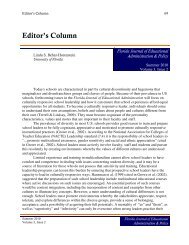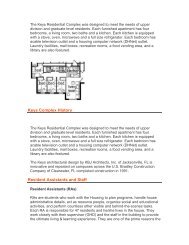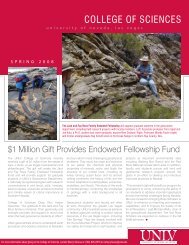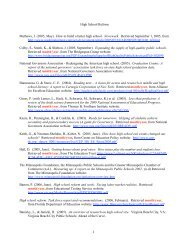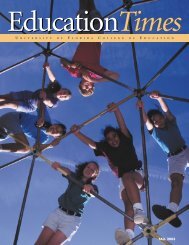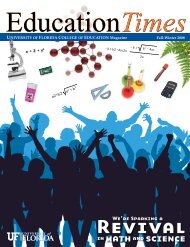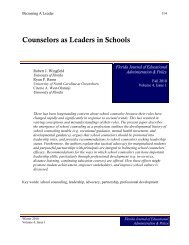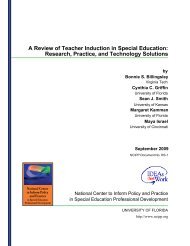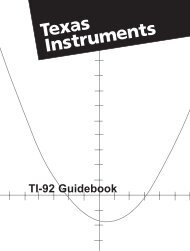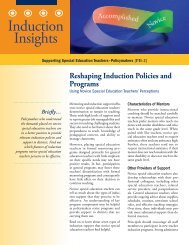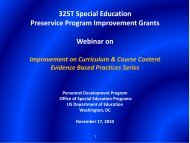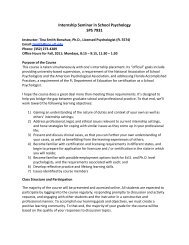Curriculum in Juvenile Corrections - College of Education
Curriculum in Juvenile Corrections - College of Education
Curriculum in Juvenile Corrections - College of Education
Create successful ePaper yourself
Turn your PDF publications into a flip-book with our unique Google optimized e-Paper software.
University <strong>of</strong> Florida Project LIBERATEMary Anne Ste<strong>in</strong>berg &Erica JacobsUniversity <strong>of</strong> Florida
Open<strong>in</strong>g Activity Th<strong>in</strong>k <strong>of</strong> 1 word and 1 word only to describe thecurriculum that is currently be<strong>in</strong>g used at your facility. Share your word with the group. If your word is shared before you are called upon, youmust come up with a new word to describe the curriculumat your site. What do you notice about the words that were used todescribe curriculums <strong>in</strong> juvenile facilities?University <strong>of</strong> Florida Project LIBERATE
<strong>Curriculum</strong> def<strong>in</strong>ed 1935 Caswell & Campbell def<strong>in</strong>ed curriculum as: “The experiences students have under the guidance <strong>of</strong>teachers” 1974 Saylor and Alexander def<strong>in</strong>ed curriculum as: “All the learn<strong>in</strong>g opportunities that are provided to thestudent from the school” 1982 Oliva def<strong>in</strong>ed curriculum as: “Was a plan or program <strong>of</strong> all the experiences that a studentwould encounter while under the direction <strong>of</strong> the school”University <strong>of</strong> Florida Project LIBERATE
<strong>Curriculum</strong> def<strong>in</strong>ed 2009 Burroughs and Smagor<strong>in</strong>sky def<strong>in</strong>edcurriuculum as: “The ‘what’ <strong>of</strong> <strong>in</strong>struction” The learn<strong>in</strong>g expectations <strong>of</strong> teachers and otherstakeholders outl<strong>in</strong>ed <strong>in</strong> the requirements <strong>of</strong> statestandards, scope and sequence outl<strong>in</strong>es, and lessonplansUniversity <strong>of</strong> Florida Project LIBERATE
Curricular Issues <strong>in</strong>:<strong>Juvenile</strong> <strong>Corrections</strong> Student diversity <strong>in</strong> academic function<strong>in</strong>g level A Crim<strong>in</strong>ological Perspective vs. Pr<strong>in</strong>ciples <strong>of</strong> PositiveCrim<strong>in</strong>ology Morrison and Epps (2002) stated: “Youth <strong>in</strong> JC are the most educationallydisadvantaged <strong>in</strong> our society.” ( p. 218) Krezmien & Mulcahy, 2008;Morrison and Epps ,2002University <strong>of</strong> Florida Project LIBERATE
There are several reasons why curriculum <strong>in</strong>JC needs to be explored. Youth <strong>in</strong> JC are function<strong>in</strong>g below the means on allmeasures <strong>of</strong> achievement Baltodano, Harris & Rutherford, 2005 Standards for core content may not be addressed <strong>in</strong>classrooms where students are work<strong>in</strong>g at multiple levelsand work<strong>in</strong>g out <strong>of</strong> workbooks Leone & Cutt<strong>in</strong>g, 2004 Students who are special education cont<strong>in</strong>ue to sufferacademically because they lack access to general educationcurriculum O’Rourke & Gordon, 2003University <strong>of</strong> Florida Project LIBERATE
Why cont<strong>in</strong>ued… It can be the last opportunity that some students willever have to receive academic and vocationaleducation We need to provide them with: Research based materials Pr<strong>of</strong>essional development to support curriculum Resources to support curriculumUniversity <strong>of</strong> Florida Project LIBERATE
What curriculum can provide… By mov<strong>in</strong>g toward the pr<strong>in</strong>ciples <strong>of</strong> positive crim<strong>in</strong>ologywe can provide juveniles with educational opportunities,especially those that go beyond walls <strong>of</strong> facility and allowstudents to adopt legitimate roles <strong>in</strong> society and help withrehabilitation . Empey & Stafford, 1999 S<strong>in</strong>ce the overall purpose <strong>of</strong> correctional education is toengage youth with positive educational experiences andprepare them for successful reentry to their schools andcommunities ; we must f<strong>in</strong>d ways to <strong>in</strong>crease the academicfunction<strong>in</strong>g <strong>of</strong> these students while they are <strong>in</strong> our care. Leone, Krezmien, Mason & Meisle, 2005University <strong>of</strong> Florida Project LIBERATE
And as if that wasn’t reasonenough… By improv<strong>in</strong>g their academic function<strong>in</strong>g we may alsobe able to lower the recidivism rates for these students Shelley‐Treblay, O’Brien, & Lang<strong>in</strong>richsen‐Rohl<strong>in</strong>g, 2007University <strong>of</strong> Florida Project LIBERATE
NCLB, IDEA & Florida StatutesUniversity <strong>of</strong> Florida Project LIBERATE
No Child Left Beh<strong>in</strong>d One goal <strong>of</strong> NCLB (1401.a.1 ) is to ensure that : improvements are made to the educational servicesfor students <strong>in</strong> local and state juvenile corrections, so that they are be<strong>in</strong>g given the opportunity to<strong>in</strong>teract and engage with the state academiccontent standards so that they may cont<strong>in</strong>ue toachieve the same educational goals as their non<strong>in</strong>carceratedpeers. Access to this core curriculum is important if studentsare to be able to show adequate yearly progress asmandated by NCLBUniversity <strong>of</strong> Florida Project LIBERATE
IDEA IDEA is another document that has a tremendous impacton the curricular decisions made concern<strong>in</strong>g students withdisabilities. IDEA (2006, 34 C.F.R.71 Sec. 300.110) says the state mustensure that public agencies (<strong>in</strong>clud<strong>in</strong>g JC) take steps toensure children with disabilities have available thevariety <strong>of</strong> educational programs and services availableto nondisabled children <strong>in</strong> the area.This <strong>in</strong>cludes art, music, <strong>in</strong>dustrial arts, consumer andhomemak<strong>in</strong>g education, and vocational education, as well as thecore content areas <strong>of</strong> read<strong>in</strong>g, writ<strong>in</strong>g, mathematics, social studiesand science.University <strong>of</strong> Florida Project LIBERATE
Florida State Statutes Students are required to work with core curriculumcontent for language arts, science, math, and socialstudies (09 FL Stat 1003.41(1)) Additionally, students <strong>in</strong> JC must have access tovocational and career education programs (09 FLStat 1003.52 & Stat 1003.01(4); NCLB 1421.1) District school boards <strong>in</strong> Florida must also provideadequate <strong>in</strong>structional materials for all students,<strong>in</strong>clud<strong>in</strong>g those <strong>in</strong> JC (FL Stat 1006.28)University <strong>of</strong> Florida Project LIBERATE
University <strong>of</strong> Florida Project LIBERATE
Barriers and Facilitators <strong>of</strong> Provid<strong>in</strong>gStudents <strong>in</strong> JC with Quality <strong>Education</strong> Purpose <strong>of</strong> the study: The authors <strong>of</strong> this article complied a list <strong>of</strong> barriers andfacilitators to provid<strong>in</strong>g youth <strong>in</strong> DJJ a quality education9 themes emerged: personnel concerns, academics, studentconcerns, discipl<strong>in</strong>e, materials and supplies, parental<strong>in</strong>volvement, fund<strong>in</strong>g, communication & facilities Method: 78 teachers form 3 facilities <strong>in</strong> the south completed the survey2009, Houch<strong>in</strong>s, Puckett‐Patterson, Crosby, Shippen & JolivetteUniversity <strong>of</strong> Florida Project LIBERATE
Results Academics: expectations <strong>of</strong> state and facility not meet<strong>in</strong>g needs <strong>of</strong>students outside problems <strong>in</strong>terfer<strong>in</strong>g with class work lack <strong>of</strong> student access to extracurricular activities heterogeneity <strong>of</strong> class a negative effect on reach<strong>in</strong>gacademic goalsUniversity <strong>of</strong> Florida Project LIBERATE
Results cont<strong>in</strong>ued… Materials & Supplies: poor facilities and supplies a barrier needed more academic material <strong>in</strong> general Fund<strong>in</strong>g: to purchase materials and supplies upgrade libraries new technology hire more staffUniversity <strong>of</strong> Florida Project LIBERATE
Characteristics & Approaches to<strong>Curriculum</strong> Purpose <strong>of</strong> Study: To <strong>in</strong>vestigate school‐level curriculumpolicies and practices <strong>in</strong> JC schools; Current study <strong>in</strong>vestigated(a) What are the pr<strong>in</strong>cipal, school and student characteristics?(b) How do student characteristics relate to length <strong>of</strong> enrollment?(c) What are the primary responsibilities <strong>of</strong> the school?(d) What are the curricular policies, practices, andphilosophies and how do they compare across schoolcharacteristics? Method:Survey <strong>of</strong> 131 pr<strong>in</strong>cipals from a national databaseIn 2009, Gagnon, Barber, VanLoan, and LeoneUniversity <strong>of</strong> Florida Project LIBERATE
Results: Primary emphasis Help<strong>in</strong>g students get a high school diploma Help<strong>in</strong>g students get a GED diploma Other primary emphasis Remediation <strong>College</strong> preparation Help students with <strong>in</strong>dividual needs Transition to public school Treatment CitizenshipUniversity <strong>of</strong> Florida Project LIBERATE
Results cont<strong>in</strong>ued… <strong>Curriculum</strong> and supports aligned with state assessments toa great extent: SEA or LEA curriculum…………………………………………………68.2% Math aligned with state standards…………………………………73.6% Read<strong>in</strong>g aligned with state standards…………………………….74.4% Instruct materials aligned with state standards…………….68.5% Supervised to ensure alignment with curriculum and stateassess……………………………………………………………………………..61.5% Pr<strong>of</strong>essional development <strong>of</strong>fered to ensure alignment….61.5%NOTE: 54.5% <strong>of</strong> adm<strong>in</strong>istrators felt grade level expectationsshould not apply to every student with emotional behavioraldisorders or learn<strong>in</strong>g disabilitiesUniversity <strong>of</strong> Florida Project LIBERATE
State‐Level Curricular Practices for ExclusionarySchool Sett<strong>in</strong>gs Purpose <strong>of</strong> study: To <strong>in</strong>vestigate:1. What is the basis <strong>of</strong> the curriculum?,2. What were the respondents view <strong>of</strong> the curriculum?,3. What was the respondents view <strong>of</strong> students tak<strong>in</strong>gstate level assess?,4. What are the state level assessment and accountabilitypolicies? Method: A national survey <strong>of</strong> LEA directors <strong>of</strong> specialeducation, and adm<strong>in</strong>istrators <strong>of</strong> JC and DTR schools 2010, GagnonUniversity <strong>of</strong> Florida Project LIBERATE
Results on <strong>Curriculum</strong> Questions <strong>Juvenile</strong> <strong>Corrections</strong> schools reported: Reported that curriculum was based on SEA or LEAapproved curriculum……………………………………………….56%10.42% LEA did not have policy Use SEA curriculum………………………………………………..25% Use LEA curriculum……………………………………………..31.25% Schools develops own curriculum ………………………16.66% IEP used to determ<strong>in</strong>e curriculum……………………….10.42%University <strong>of</strong> Florida Project LIBERATE
Results Cont<strong>in</strong>ued 89.13% (n=41) reported that help<strong>in</strong>g students earn a high school diploma wasthe most important th<strong>in</strong>g they did; earn<strong>in</strong>g GED was the next priority 66.67%(n=30) Priority for special education students <strong>in</strong> juvenile correctionsHigh school diploma Most important= 89.13% n=41 Important= 2.17% n=1 Least important= 8.70% n=4GED Most important= 6.67% n=3 Important= 66.67% n= 30 Least important= 26.66% n=12Vocational <strong>Education</strong> Most important= 11.63% n=5 Important= 34.88% n=15 Least important= 53.49% n=23University <strong>of</strong> Florida Project LIBERATE
Results Cont<strong>in</strong>ued Gagnon (2008) 37% <strong>of</strong> schools create school based or <strong>in</strong>dividualstudent curriculum vs. district curriculum The problem with us<strong>in</strong>g a school developed or <strong>in</strong>dividualcurriculum is that:It may not prepare students to pass state level assess and cause lack<strong>of</strong> AYP, By us<strong>in</strong>g IEPs to decide student curriculum you may be <strong>in</strong>hibit<strong>in</strong>gthe student’s access to general education curriculum What rema<strong>in</strong>s to be discovered is how or when functionalalternatives should be used with older students or students whohave few to no high school credits when they exit the juvenilecorrections facility…University <strong>of</strong> Florida Project LIBERATE
Of a North Florida <strong>Juvenile</strong> Justice FacilityUniversity <strong>of</strong> Florida Project LIBERATE
A Case Study <strong>of</strong> a North FloridaFacilityQualitative case study design was selected because: It facilitates exploration <strong>of</strong> a phenomenon with<strong>in</strong> itscontext us<strong>in</strong>g a variety <strong>of</strong> data sources. This ensures thatthe issue is not explored through one lens, but rather avariety <strong>of</strong> lenses which allows for multiple facets <strong>of</strong> thephenomenon to be revealed and understood” Baxter & Jack, 2008, p. 544University <strong>of</strong> Florida Project LIBERATE
Our Research ProcessDocument Review• Student &FacultyHandbooks• <strong>Education</strong>alQualityAssuranceStandards forResidential<strong>Juvenile</strong> JusticePrograms• LEA DocumentsSurveys• Teachers• Adm<strong>in</strong>istrator• Parapr<strong>of</strong>essionalsInterviews• Teachers• Adm<strong>in</strong>istrators• Parapr<strong>of</strong>essionals• Youth CareWorkers• GuidanceCounselor• StudentsUniversity <strong>of</strong> Florida Project LIBERATE
Document Review Student & Faculty Handbooks: Teacher: lesson plans, curricular guides, screen<strong>in</strong>g & assessment,feedback on student performance Students: educational options if student already had a GED <strong>Education</strong>al Quality Assurance Standards for Residential<strong>Juvenile</strong> Justice Programs Options for GED, guidance counselor, educational options, meet<strong>in</strong>gstate standards, vocational standards, curricular options LEA Documents <strong>Curriculum</strong> guides to meet SSS, course list<strong>in</strong>gs, student feedbackUniversity <strong>of</strong> Florida Project LIBERATE
Survey Teacher: “How <strong>of</strong>ten do you develop a school curriculum or part <strong>of</strong> it?”Of the 3 teachers who responded: 1 said “monthly”, 1 said less than“once per year”, and the third said “never” “Concern<strong>in</strong>g the feedback and evaluations you have receivedat this school, to what extent have they directly led to or<strong>in</strong>volved changes to your understand<strong>in</strong>g <strong>of</strong> your ma<strong>in</strong> subjectfield?”2 teachers responded that this was “considered with highimportance,” while the 3 rd teacher stated it was “considered withmoderate importance”University <strong>of</strong> Florida Project LIBERATE
Teacher Survey Cont<strong>in</strong>ued Th<strong>in</strong>k<strong>in</strong>g <strong>of</strong> your pr<strong>of</strong>essional development needs doyou need pr<strong>of</strong>essional development <strong>in</strong>:Content and performance standards <strong>in</strong> my subject area 2 teachers responded that this was a “high level <strong>of</strong> need” andthe other teacher stated this was a “moderate level <strong>of</strong> need”Knowledge and understand<strong>in</strong>g <strong>of</strong> my subject area” 1 teacher stated this was a “high level <strong>of</strong> need”, the secondteacher responded this was, “ a moderate level <strong>of</strong> need”, andthe third teacher felt this was a “low level <strong>of</strong> need”University <strong>of</strong> Florida Project LIBERATE
Survey Adm<strong>in</strong>istrator: “How frequently do you do you ensure that there isclarity concern<strong>in</strong>g the responsibility for coord<strong>in</strong>at<strong>in</strong>gcurriculum”Our adm<strong>in</strong>istrator responded, “very <strong>of</strong>ten” “How important is teacher knowledge andunderstand<strong>in</strong>g <strong>of</strong> <strong>in</strong>structional practices <strong>in</strong> their subjectarea?”The response was, “Considered with high importance”University <strong>of</strong> Florida Project LIBERATE
Interviews Teacher “Describe the curriculum you use.”“I have no textbooks, I try to follow the LEA curriculum and make adaptationsand modifications to it. I teach basic read<strong>in</strong>g skills”“I don’t have full texts or even a teacher’s edition, I pull <strong>in</strong>formation from the<strong>in</strong>ternet…” “How appropriate is it for the students you teach?”“I use EdHelper, it allows for flexibility.”“My son is <strong>in</strong> high school now so I ‘borrow’ a lot from his school and teachers” “How does it <strong>in</strong>corporate the Sunsh<strong>in</strong>e State Standards?”“I use them, I teach them”“I follow the plans from other teachers <strong>in</strong> the district” “How does it provide access for special education students?”“It doesn’t”“I don’t know what the Access Po<strong>in</strong>ts are…”University <strong>of</strong> Florida Project LIBERATE
Interviews Cont<strong>in</strong>ued Adm<strong>in</strong>istrator “In what ways do you ensure that teachers are adher<strong>in</strong>gto state, district and facility standards?”“We do walk throughs on a weekly basis, formal evaluations,distric level staff come out and do teacher observations” “How does your facility participate <strong>in</strong> accountability andmeet<strong>in</strong>g AYP?”“We do not measure AYP (not true AYP) we set goals forstudents like read<strong>in</strong>g at a certa<strong>in</strong> percent, but we don’t getgrades like other schools”University <strong>of</strong> Florida Project LIBERATE
Case Study Conclusions Com<strong>in</strong>g soon… What are your thoughts?University <strong>of</strong> Florida Project LIBERATE
University <strong>of</strong> Florida Project LIBERATE
Contact Information Mary Anne Ste<strong>in</strong>berg University <strong>of</strong> Florida manabet@ufl.edu Erica Jacobs University <strong>of</strong> Florida tiftay@ufl.edu For additional <strong>in</strong>formation, and to download a copy <strong>of</strong> thispresentation, please visit:http://coe.ufl.edu/Projects/liberateUniversity <strong>of</strong> Florida Project LIBERATE
References Baltodano, H. M., Harris, P. J. & Rutherford, R. B. (2005) Academic achievement <strong>in</strong>juvenile corrections: Exam<strong>in</strong><strong>in</strong>g the impact <strong>of</strong> age, ethnicity, and disability. <strong>Education</strong>and Treatment <strong>of</strong> Children, 28, 361‐379. Burroughs, R. & Smagor<strong>in</strong>sky, P. (2009) The secondary English curriculum andadolescent literacy. In L. Christenbury, R. Bomer & P. Smagor<strong>in</strong>sky (Ed.) Handbook <strong>of</strong>adolescent literacy research (pp. 170‐182). New York, NY; The Guilford Press. Common Core Standards Initiative (2010) The Standards English Language Arts andMathematics. Retrieved July 4, 2010. From Common Core Standards Web site:http://www.corestandards.org/the‐standards/langugae‐arts‐standards. Florida department <strong>of</strong> <strong>Education</strong> (2010) <strong>Curriculum</strong> Frameworks. Retrieved July 4, 2010.From Florida Department <strong>of</strong> <strong>Education</strong> Web site: http://fldoe.org/workforce/dwdframe/. Foley, R. M. (2001) Academic characteristics <strong>of</strong> <strong>in</strong>carcerated youth and correctionaleducation programs. Journal <strong>of</strong> Emotional & Behavioral Disorders, 9, Gagnon, J. C. (2010). State‐Level curricular, assessment, and accountability policies,practices, and philosophies for exclusionary school sett<strong>in</strong>gs. The Journal <strong>of</strong> Special<strong>Education</strong>, 43, 206‐219. Gagnon, J.C., Barber, B. R., Van Loan, C. & Leone, P. E. (2009) <strong>Juvenile</strong> correctionalschools: Characteristics and approaches to curriculum. <strong>Education</strong> and Treatment <strong>of</strong>Children, 32, 673‐696.University <strong>of</strong> Florida Project LIBERATE
References Houch<strong>in</strong>s, D. E., Puckett‐Patterson, D. S., Crosby, S., Shippen, M. E., & Jolivette, K.(2009). Barriers and facilitators to provid<strong>in</strong>g <strong>in</strong>carcerated youth with a quality education.Prevent<strong>in</strong>g School Failure, 53, 159‐166. IRA/NCTE (2010) IRA/NCTE Standards for the English Language Arts. Retrieved July 4,2010, from the National Council <strong>of</strong> Teachers <strong>of</strong> English Web site:http://www.ncte.org/standards Jackson, P. W. (1992) Conceptions <strong>of</strong> curriculum and curriculum specialists. In P.W.Jackson (Ed.) Handbook <strong>of</strong> research on curriculum (pp. 3‐40). New York, NY: MacmillianPublish<strong>in</strong>g Company.Krezmien, M. P., & Mulcahy, C. A. (2008). Literacy and del<strong>in</strong>quency: Current status <strong>of</strong>read<strong>in</strong>g <strong>in</strong>terventions with deta<strong>in</strong>ed and <strong>in</strong>carcerated youth. Read<strong>in</strong>g & Writ<strong>in</strong>gQuarterly, 24, 219‐238. Krezmien, M. P., Mulcahy, C. A., & Leone, P. E., (2008) Deta<strong>in</strong>ed and committed youth :Exam<strong>in</strong><strong>in</strong>g differences <strong>in</strong> achievement, mental health needs and special education status.<strong>Education</strong> and Ttreatment <strong>of</strong> Children, 31, 445‐464.Leone, P. E., & Cutt<strong>in</strong>g, C. A. (2004) Appropriate education, juvenile corrections, and NoChild Left Beh<strong>in</strong>d. Behavioral Disorders, 29, 260‐265.Leone, P. E., Krezmien, M., Mason, l., & Meisle, S. M., (2005) Organiz<strong>in</strong>g and deliver<strong>in</strong>gempirically based literacy <strong>in</strong>struction to <strong>in</strong>carcerated youth. ExceptionaliltyUniversity <strong>of</strong> Florida Project LIBERATE
ReferencesMalmgren, K. W. & Leone, P. E. (2000). Effects <strong>of</strong> a short‐term auxiliary read<strong>in</strong>g programon the read<strong>in</strong>g skills <strong>of</strong> <strong>in</strong>carcerated youth. <strong>Education</strong> and Treatment <strong>of</strong> Children, 23, 239‐247.Morrison, H. R. & Epps, B. D. (2002) Warehous<strong>in</strong>g or rehabilitation? Public school<strong>in</strong>g <strong>in</strong>the juvenile justice system. Journal <strong>of</strong> Negro <strong>Education</strong>, 71, 218‐232.National Council for Teachers <strong>of</strong> Mathematics (2009) Pr<strong>in</strong>ciples and standards for schoolmathematics: An overview. Retrieved from The National Council <strong>of</strong> Teachers <strong>of</strong>Mathematics Web site: http://standards.nctm.org/documents/chapter7/<strong>in</strong>dex.htmPlatt, J. S., Casey, R. E., & Faessel,R. T. (2006) The need for a paradigmatic change <strong>in</strong>juvenile correctional education. Prevent<strong>in</strong>g School Failures, 51, 31‐38.Shelley‐Tremblay, J., O’Brien, N. O., & Lang<strong>in</strong>richsen‐Rohl<strong>in</strong>g, J. (2007) Read<strong>in</strong>gdisability <strong>in</strong> adjudicated youth: Prevalence rates, current models, traditional and<strong>in</strong>novative treatments. Aggression and Violent Behavior, 12, 376‐392. United States Census Bureau News (2010). Facts and Features Back to School: 2010‐2011.Retrieved July 5, 2010, from U.S. Census News Web site:http://ww.census.gov/newsroom/releases/pdf/cb1Off‐14_school.pdfUniversity <strong>of</strong> Florida Project LIBERATE



